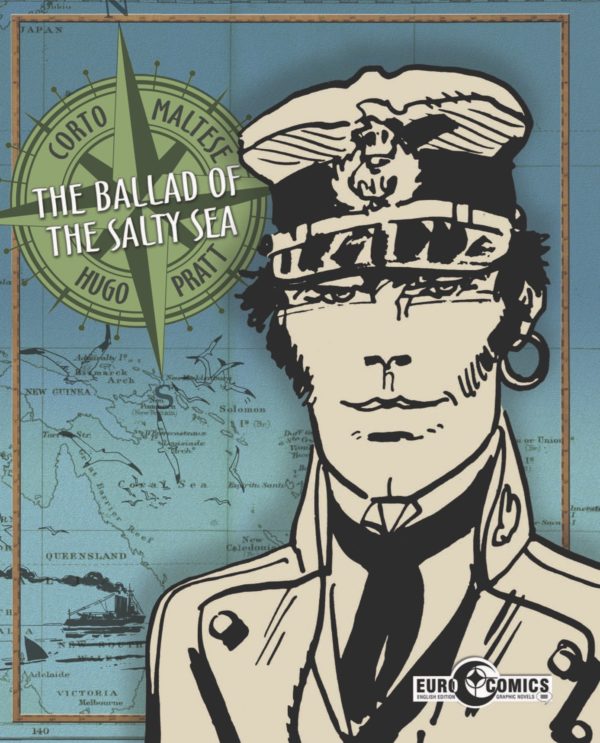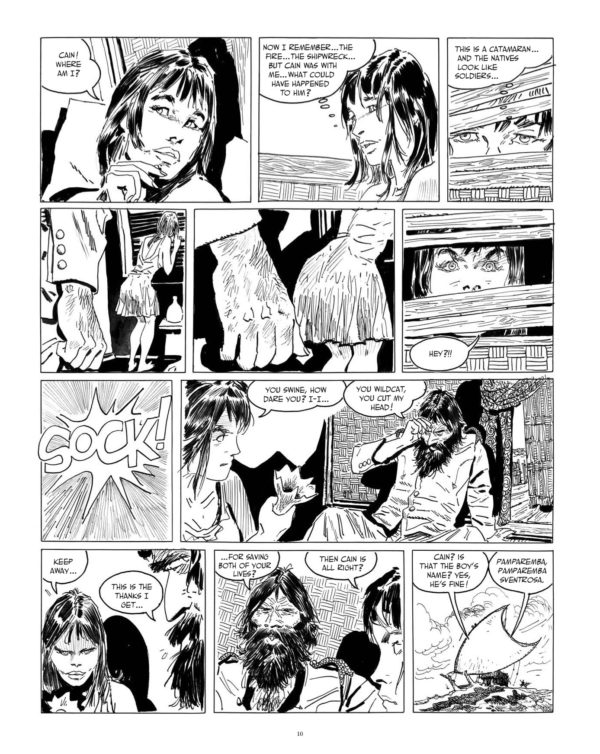Corto Maltese: The Ballad of the Salty Sea
By Hugo Pratt
Translated by Dean Mullaney and Simone Castaldi
IDW/EuroComics
Though I had known about Corto Maltese for years, I had only ever sat down and read one of Hugo Pratt’s Maltese books upon its reissue of The Ballad of the Salty Sea in 2012 from Rizzoli. I thoroughly enjoyed it and appreciated the old fashioned aspects of the characters and plots, but admit that it was encumbered by some production values.
By all accounts, the more recent reissues by EuroComics from IDW — there have been three so far — have been just as rousing, and though in black and white, with crisp, pretty flawless production quality that far surpasses the Rizzoli effort, and a new translation by Dean Mullaney and Simone Castaldi.. I took a look at this new edition of The Ballad of the Salty Sea to find out for myself and I’m pleased to say that the reports are correct.
In chronological terms, The Ballad of the Salty Sea is the second in Pratt’s Corto Maltese series. When we meet Maltese in this book, he is a scurrilous pirate in the Pacific seas of pre World War I, rescued from a sure death onboard a floating raft by his apparently permanent foil, Rasputin, another pirate who greatly resembles the monk of the same name. Perhaps that’s what makes their connection an in-joke — they both work for a mysterious smuggler who actually goes by the name The Monk.
Maltese might be a brigand, but he’s a well-humored and honorable one who has earned the respect other sea-faring types, but most of all, the victims of a ransom scheme that he’s embroiled in — the rich Groovesnore cousins, Cain and Pandora. Teenage Pandora specifically bonds with Maltese, offering an unlikely and unrealized romantic tone to the adventure, one throwback to another era that is admittedly outdated and possibly offensive to some modern readers. On the other hand, if you think in terms of Terry and the Pirates or Steve Canyon, but with a European frankness and unapologetic darkness that never turns its back on the concept that Maltese is a scoundrel and bad things do happen in his world, it does make sense.
Pratt’s story speaks to the end of colonialism, which the world still grappled with in direct ways, and the mannered, authoritarian system of Great Britain finds itself provoked by those who don’t fit into their convenient world order. This sort of wild card is personified by the character of Maltese, whose very existence runs in opposition to the staid and desperate attempts of England to keep the world under control. Maltese is the face of the future.
In story terms The Ballad of the Salty Sea represents the pure adventurous spirit of what has appealed to European audiences about Corto Maltese for so long. Reading it in the 21st Century from an American perspective, the European view of world politics of the time it was originally created — it began serialization in 1967 and was collected in book form in 1976 — offer another side-point of interest to an adventure story that honestly would probably be viewed as a beloved classic of the genre in our own country if it ever had a real opportunity to be so.












This is an all-time classic that I had the chance to read when it was first published in France by Casterman in its original and glorious Black & White. Any serious comic book reader should have a shelf devoted to Hugo Pratt’s ouvre he is one of the geniuses in this field and it’s a shame that the US waited so long for it.
“The Ballad of the Salty Sea” is the eleventh “Corto Maltese” volume issued by IDW Eurocomics, not the third. They started with “Under the Sign of Capricorn” and moved forward through his career through “The Secret Rose” novella, which left only “Mu: The Lost Continent”. That’s when they went back and published “The Early Years” and “Ballad of the Salty Sea”. I too started reading “Corto Maltese” with the 2012 translation, so I didn’t realize how badly it was mangled until the recent IDW version. I know “BSS” is the first appearance of Corto Maltese, but it’s also the least “Corto Maltese” of all the volumes– he’s more of a side character here, which doesn’t make it the best introduction to the character. Still a good read, though, and it hints at the greatness that is to come.
Comments are closed.